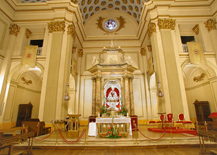
Locality: PAMPLONA (31001)
Address: Calle Mayor (iglesia de San Lorenzo), 74
Zone: The Pamplona Basin
Style: Neoclassical
Centuries of construction: XVII-XVIII
Price of the visit: Entrada gratuita
Tel.: 948225371
The Church of San Lorenzo
If the streets of Pamplona are the main stage for the world famous San Fermín festival, the Saint’s Chapel, situated inside the Church of San Lorenzo, acts as the focal point for the faithful, who meet there to celebrate religious events in honour of the city’s patron saint.
The City Council attends the church in full ceremonial regalia on July 6th every year, just a few hours after the chupinazo (ceremonial rocket) that inaugurates the festivity. Vespers of the main day of the fiesta, July 7th, are celebrated with a Mass, the only day of the year when the saint’s reliquary, a polychromed, silver-covered wooden sculpture from the 15th century, leaves its home in a chapel of the Church of San Lorenzo to take part in the procession through the old quarter of the city. This takes place under the devoted and emotional gaze of thousands of pamploneses, as well as visitors from all over the world. The chapel then goes back to being a major protagonist in the religious activities of the Octava (Octave, or eighth Mass) which ends the eight-day festival.
On any other day of the year it is customary for locals and visitors to meet on this spot at the end of Calle Mayor (High Street). It is also customary for many engaged couples to want to get married in front of its altar, for which it is necessary to book a date many years in advance. It is in The Church of San Lorenzo, of average architectural value but strong in deep-rooted sentimental value, that all the official religious activities during San Fermín take place.
Today, hardly a single tower remains of the original mediaeval church, which formed part of Pamplona’s defensive system in years gone by. It is a curious fact that the Church of San Lorenzo, bearing an Aragonese name, was erected in the Frankish borough of St. Cernin by the people of Pamplona who lived there, since the Franks (freemen mainly of French origin who were endowed with great privileges) did not allow the locals to share their meeting places.
The present church was built in the 18th century, faithful to the neoclassical realism that replaced the ruined 14th century building. It has a Greek cross layout within a square and has a single nave. The geometrical design of its domes and the lantern in exposed brickwork that crowns its upper section are quite striking. Carefully laid, this brickwork appears to be uniformly flecked with coloured ceramic that contains the city’s coat of arms and contrasts with the stone of the arched gallery on the ground floor.
Chapel of San Fermín
The most esteemed part of The Church of San Lorenzo is undoubtedly the Chapel of San Fermín. This chapel, neoclassical in appearance, is just on the right as you enter; above the altar stands the venerated reliquary of the saint, a half-height sculpture dating from the 15th century made of polychromed wood and gilded with silver. His face is dark, either due to the fact that it was originally black or that smoke from the candles has darkened it. It is for this reason that the affectionate epithet of morenico (the dark-skinned one) has been given to the saint.
San Fermín
San Fermín was the first bishop of the city and is now the patron saint of Pamplona along with San Saturnino. Legend has it that Fermín, son of the senator Firmus, who governed Pamplona in the 3rd century, converted to Christianity and was ordained as a priest in Toulouse. He returned to Pamplona as bishop and died a martyr in France on 25th September 303.
The image of San Fermín is a reliquary bust of polychromed wood, bathed in silver hues with a neat floral decoration, which is not normally visible, since the saint is covered by his red and gold cape. This is why young people taking part in the bull run call him the capotico (the one with the cape) and invoke the saint to lend them a hand (literally to “throw them a cape”) to protect themselves from the danger of running before the bulls. In the oval locket on his chest there are several relics, which came here in the 16th century from Amiens, the French city where the saint was beheaded in 303.
The image was placed here on July 6th 1717 and since then it only leaves this chapel on July 7th, the Day of San Fermín, to take part in the procession through streets lined with people dressed in the red and white ?uniform’ of the fiesta. The saint is venerated along the way with songs, dances, prayers and the emotional sentiments of thousands of the people of Pamplona.







